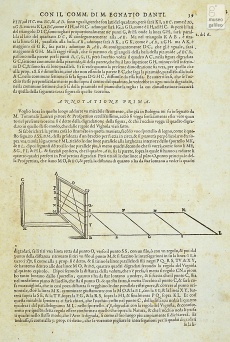Perspectograph by Tommaso Laureti
From Inventions
(Created page with '{{Template invention |nome= Has no specific name. |inventore= Tommaso Laureti (1530-1602) |data= ca. 1580 |descrizione= Invented by the Sicilian painter Tommaso Laureti, the …') |
Current revision as of 10:37, 27 July 2010
Has no specific name.
Contents |
Inventor
Tommaso Laureti (1530-1602)
Historic Period
ca. 1580
Description
Invented by the Sicilian painter Tommaso Laureti, the instrument seems to have been designed more for educational than for purely graphic purposes. It consisted of a frame with a set of strings that the painter positioned, having established the viewing point, superimposing them optically on a set of orthogonal lines traced on the plane beyond the frame. The frame was supposed to demonstrate the biunivocal correspondence between the parallel lines of the real configuration and the converging ones of the perspective drawing.
Egnazio Danti, Le due regole della prospettiva pratica di Jacopo Barozzi da Vignola [The two rules of practical perspective of Jacopo Barozzi da Vignola] Rome, 1583. Theor. XXVII, prop. XXXIII: “That a figure parallel to the horizon is seen, by an eye that is not on the same plane, progressively diminished.” First annotation, p. 39: “I would like to speak here of an admirable instrument, which was taught to me in Bologna by M. Tommaso Laureti, most excellent painter and Perspective theorist, to demonstrate clearly what has been said in this theorem about the progressive receding of the figure...”
Bibliographical Resources
Vignola, Giacomo Barozzi detto il. Le due regole della prospettiva pratica. Con i comentarij del R.P.M. Egnatio Danti. In Roma, per Francesco Zannetti, 1583, teor. XVII, prop. XXXIII; p. 39.
Images
Author of the entry: Filippo Camerota

